2025 CHRISTINA DÖRFLER
Dobrila Denegri: Let’s begin with how you entered this line of research, which led you to explore alternative methods of treating textile surfaces and dyeing them with various, mainly natural, pigments. I find it fascinating that your work can be loosely linked to geoscience, geology, palaeontology, and similar fields of scientific inquiry that look back to prehistoric eras. How did you explore the area of Hallstatt, and what discoveries were made there?
Christina Dörfler: During my studies at the University of Applied Arts in Vienna, I began to see colour differently—no longer as a purely aesthetic choice, but as a medium that carries memory: geological, cultural, and archaeological. This shift in perspective transformed my practice and eventually drew me to the Hallstatt region. Its prehistoric salt mines and burial sites hold an extraordinary archive of human life, where geology and history are inseparably intertwined. The very salt that enabled millennia of mining also preserved artefacts buried within—tools, clothing, and even delicate traces of colour—allowing them to survive in exceptional condition.
The textiles discovered in Hallstatt are among the oldest and best preserved in Europe, dating back to the 15th century BC. Their survival is astonishing: coarse wool sacks once used for transporting salt remain alongside finely woven decorative bands and garment fragments that reveal a remarkably advanced understanding of weaving and dyeing techniques. Subtle yet vivid traces of blue, red, and yellow still cling to the fibres—pigments drawn from minerals, plants, and soils unique to the region. These colours do more than speak of craft; they illuminate trade networks, environmental knowledge, and the symbolic significance of colour in prehistoric societies.
My engagement with Hallstatt deepened through the interdisciplinary research project “Dyeing Techniques of Prehistoric Hallstatt Textiles: Analyses, Experiments, and Inspiration” (2008–2012), funded by the Austrian Science Fund (FWF). This collaboration united the Department of Textile Arts at the University of Applied Arts Vienna with the Institute of Art and Technology, the Departments of Archaeometry and Textile Technology, and a wide network of partners: the Natural History Museum Vienna, the University of Natural Resources and Life Sciences Vienna, the Society for Textile-Art-Research, Blaudruckerei Koó (a traditional indigo dye and printing workshop), and the Cultural Heritage Agency of the Netherlands.
Working closely with scientists, archaeologists, and craftspeople allowed me to enter into a dialogue with prehistoric makers themselves—learning from the traces they left behind and translating these insights into a contemporary artistic language.
In the museum’s laboratories, I studied textile fibres and pigments preserved for over three thousand years. Analyses revealed colour sources still present in the Hallstatt landscape—iron-rich clays, plant dyes, mineral residues from the salt itself. By recreating these dyeing processes with local materials, I discovered tonalities specific to Hallstatt’s geological signature.
Yet in the burial sites of Hallstatt, the textiles themselves had long since disappeared—unlike the salt-mined finds, they were not preserved. What remained were only faint imprints on metal objects, such as woven bands once wrapped around iron knives. These ghostly traces led me to imagine the colours and materials that had once existed and to question how minerals and metals in the soil might have acted as mordants, altering or fixing dyes.
In my own work, I sought to reverse this process of disappearance. By applying corrosive materials to textiles, I allowed chemical reactions to erode and transform the fibres—echoing the slow geological processes of decay yet rendering them visible in a contemporary form. Through experiments with indigo and rust, I invited these elements to interact and leave their own imprints, creating new forms of colour and texture born out of destruction.
This approach evolved into what I now call “colour archaeology”: rather than imitating ancient methods, I allow the material and the land to guide contemporary textile explorations. Hallstatt became more than a site of study—it became both palette and methodology, a place where art, archaeology, and earth sciences converge. The colours I work with are not simply hues; they are time capsules, carrying with them the human and geological histories of a place where salt has preserved memory for thousands of years.
DD: “Wandering Tribe”, initiated in 2013, was the first collection in which you employed techniques such as rusting, bleaching, and a variety of others to create textures and patterns that are unique and irreproducible. Could you tell me more about the processes you were experimenting with?
CD: “Wandering Tribe” was my first collection in which I consciously moved away from conventional dyeing and printing techniques. I was searching for a way to let materials behave almost autonomously, to let time and chemistry leave their own imprint. Instead of imposing a motif, I began working with processes like rusting, reservation, and mineral reactions to create patterns that emerge organically and cannot be repeated.
A formative moment was working with the indigo dye master Joseph Koó, whose profound knowledge of natural indigo opened up new possibilities for me. Through these experiments, I learned to layer the deep blues of indigo with the warm, unpredictable traces of rust.
The rusting technique, for example, involved placing iron objects—chains, nails, even found tools—directly onto damp fabric and allowing oxidation to occur over days or weeks. The resulting imprints captured both the form and the unpredictable spread of the rust, almost like a photographic trace of corrosion.
I also worked with natural mordants and salts, exposing textiles to environments where humidity, minerals, and time transformed their surfaces—sometimes even burying fabrics in soil or immersing them in mineral-rich water or bleach. The aim was to foster a dialogue between the textile and its surroundings, allowing pattern and texture to emerge from interaction rather than control. The fabrics became carriers of memory, bearing traces of processes that echo erosion, weathering, and ageing in the natural world.
DD: You were part of the “Transfashional” project from the very beginning, and the way you approached it was really in tune with my concept of “exhibition-in-progress”. My idea was to utilise different museums and exhibition venues as both production and display spaces. The exhibitions we made were an attempt to challenge artists and designers to do something different, creating work based on the principle of the domino. Your “Excuse My Dust Series” was initiated as the installation in the Centre of Contemporary Art Ujazdowski Castle in Warsaw, accompanied by the performance by Jasmin Schaitl. In each new instalment, we had a new phase of the treatment and dying of the textile till the final show at the City Museum Luigi Tonini at Rimini, where we presented not just dyed textiles but a collection of garments. What was your focus with that early stage of “Excuse My Dust Series”?
CD: From the very beginning, “Excuse My Dust Series” has been about embracing process rather than striving for a final, fixed object. Being part of the “Transfashional” project allowed me to work within the idea of an “exhibition-in-progress,” where the textiles could evolve visibly from one venue to the next. This approach felt liberating to me—it treated the work almost like a living organism: reacting, transforming, and accumulating traces over time.
For the first installation at the Centre for Contemporary Art Ujazdowski Castle in Warsaw, I aimed to establish the groundwork for this transformation. The textiles on display were raw and untreated, still carrying a sense of latent potential. Coated in flour, they formed a thick crust that evoked a dystopian landscape, layered over a delicate framework of wooden sticks and branches.
During the performance, Jasmin Schaitl moved slowly across this terrain—rolling, folding, and breaking the crust with her body. Her meditative gestures heightened the audience’s awareness of the fabric’s fragility and temporality; it felt almost like introducing the textiles to the public at their “birth stage.”
At the same time, I worked with mixtures of bleach, black dye, salt, and mineral particles, allowing their reactions to unfold directly on the cloth, further eroding and transforming the landscape in real time. My focus was on revealing the first interactions between fabric, pigment, and environment—initiating a dialogue with the material and setting in motion a chain reaction that would continue to evolve throughout the subsequent exhibitions.
By the time the series reached Rimini, the textiles had already travelled, been added to, aged, and been reworked multiple times. What began as abstract lengths of cloth eventually evolved into garments, but I deliberately preserved their layered histories. The stains, faded pigments, and imperfections all testified to the journey they had undergone—a visible archive of transformation.
DD: You are still working with unorthodox dying procedures under the title “Excuse My Dust Series”, but the materials you are using now are different. What contributed to this shift?
CD: Over the years, my relationship to materials has changed profoundly. When I began “Excuse My Dust Series,” my focus was mainly on process and transformation—how dust, rust, bleach and natural pigments could create unique surfaces. But as I continued the work, I felt an increasing responsibility to think about where my materials come from and what their afterlife might be.
Several factors influenced this shift. Spending so much time in nature—especially hiking in alpine and prehistoric landscapes like Hallstatt—made me acutely aware of how fragile these environments are. Seeing firsthand the impacts of climate change on glaciers, vegetation, and even soil colours has been confronting. It pushed me toward working with more sustainable, biodegradable, and locally sourced materials, reducing chemical interventions wherever possible.
Collaboration with archaeologists and geoscientists also deepened this awareness. Understanding how ancient textiles were made from plant fibres and mineral dyes reminded me that sustainable methods are not new—they are ancestral knowledge we can relearn. I began using raw fibres, natural mordants, and pigments directly from the landscapes I was researching, creating a more immediate connection between the work and its origin.
In short, the shift wasn’t just material but conceptual. It’s about preservation as much as creation—how can the making of a textile honour and protect the landscape it comes from? Working sustainably has become inseparable from the artistic language of “Excuse My Dust Series,” allowing the work to speak both about beauty and about responsibility.
DD: How do you source the materials you are using in this series?
CD: Most of the materials I use come directly from the landscapes I spend time in. Hiking has become an essential part of my research process—almost like fieldwork. When I walk along the Geo Trail in South Tyrol or around the Red Hill near my hometown, I am constantly observing colour in the earth: the iron oxides that tint the soil red, the layers of sediments exposed by erosion, the subtle shifts in tone after rain. These natural pigments often become the starting point for my dye experiments.
I collect small amounts of earth, stones, and plant matter, always carefully and respectfully, making sure not to harm the environment. Each location has its own mineral fingerprint; for example, hikes in Zermatt, Switzerland, have led me to cooler, greyish tones derived from slate and glacial sediments, very different from the warm reds of my home region.
This way of sourcing materials turns each textile into a kind of topographic memory. The colours are not only inspired by nature—they are literally part of it. For me, this creates a deep connection between the fabric and the landscape, almost like carrying a fragment of those places forward into the work.
DD: Can you tell me a bit more about the selection of garments and items exhibited at MACRO - Museum of Contemporary Art in Rome? Is there a specific conceptual thread that interconnects coats, shirts, scarves/fabrics, and fabrics we presented in 2024?
CD: For the MACRO exhibition in 2024, I wanted to create a body of work that was both materially grounded and narrative in structure. The garments—coats, shirts, and textiles—were made from certified silk and cotton, as well as reused grain sacks and up-cycled textiles. This combination allowed me to merge historical references with sustainable practice: giving new life to everyday fabrics while keeping a strong tactile and emotional connection to the material’s origin.
The colours and textures all stemmed from pigments and sediments I gathered in and around my hometown of Vienna, as well as during hikes in Ortisei and the surrounding South Tyrolean mountains. The red soils, tonal sediments, oak galls from local forests, and iron nails collected from construction sites formed a natural palette of earthy reds, muted greys, and deep ochres. I used soybean-based binders to anchor these pigments to the fibres, letting their raw qualities remain visible rather than trying to perfect or homogenise them.
Conceptually, the collection was about mapping landscapes onto the body. Each garment carries a layered geography: coats marked with red hill iron oxides, scarves dyed with oak gall tannins, shirts washed in sediment-rich water. Seen together, they create a topographic archive, a kind of wearable cartography of the places I walked, collected, and worked in. The silhouettes were intentionally simple and timeless, so the surfaces—the traces of dust, rust, and earth—could speak for themselves.
In that sense, the exhibition wasn’t just about presenting clothing; it was about presenting geological memory and the act of walking as a form of drawing—each garment a fragment of the landscapes I move through and wish to preserve.
DD: Are there other designers whose work you perceive as something close to your interests? Do you see yourself within the Biodesign area?
CD: I often feel connected to designers and artists who work with living or evolving materials—those who see textiles not as static surfaces but as part of larger ecological or geological cycles. While I don’t strictly position myself within the Biodesign field, I do share an interest in its questions: How can materials grow, transform, or even decay as part of their design? How can our practices align with natural processes rather than control them?
My own focus is less on lab-grown materials and more on field-based biodesign—working directly with pigments, sediments, and binders sourced from landscapes, and allowing time, weather, and environment to co-author the work. In that sense, I feel close to practitioners who blend art, craft, and ecology—textile artists who use plant-based dyes, or researchers exploring microbial colour, as well as designers investigating site-specific materiality rather than universal, industrial palettes.
There are affinities, for example, with the way some biodesigners use algae or bacteria to create colour, but my process remains deeply tied to walking, collecting, and mapping—almost like geological storytelling through cloth. I like to think my work sits at the edges of biodesign: informed by it but rooted in craft and the sensory experience of the landscape.
DD: How do you approach teaching and workshops with students from the position of a practitioner engaged with experimental practice? What are your methodological approaches in education, and how much does your research influence them?
CD: Teaching and working with students are a natural extension of my practice—because experimentation, for me, is not only about making, but about sharing processes and ways of seeing. My approach is very hands-on: I invite students to enter the material dialogue themselves, rather than reproducing fixed outcomes. We often start with field observations—walking, collecting, documenting colours in situ—and then move into the studio, where those impressions are translated into dye tests or surface treatments.
Methodologically, I encourage a balance between intuition and research. On one hand, I introduce students to traditional techniques—natural dyeing, mineral pigments, historical textile practices—often drawing directly from my Hallstatt research. On the other hand, I ask them to subvert these methods: to rust, to dye, to expose fabrics to weather, to let time and environment leave their own marks. This helps them understand that materials have agency and history, and that imperfection or unpredictability can be part of the design.
My research influences teaching in two ways: conceptually and ethically. Conceptually, I share with students how colour can be more than decorative—how it can carry geological and cultural memory, become a record of place. Ethically, I emphasise sustainable sourcing, respect for landscapes, and the importance of context: asking Where does this pigment come from? And what traces does it leave behind?
Ultimately, I see workshops as spaces for collective curiosity—moments where we learn not only from techniques but from the land itself, and each other’s experiences of it.
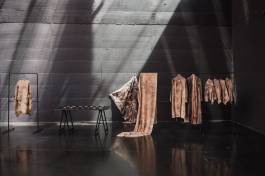
Christina Dörfler, “Excuse My Dust Series”, 2024, installation view, MACRO - Museum of Contemporary Art, Rome, within “Critical Fashion”
Photo by Natascha Unkart
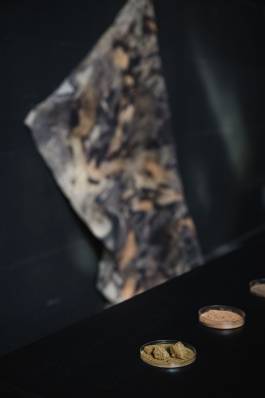
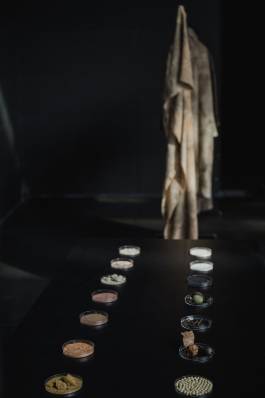
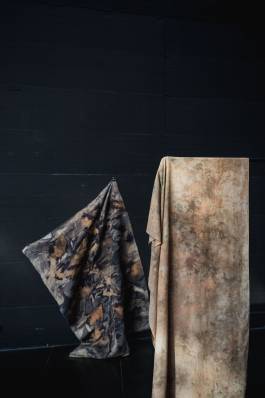
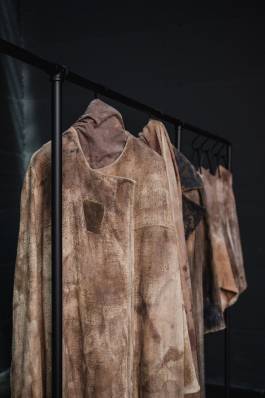
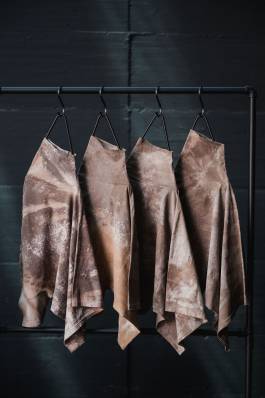
Christina Dörfler, “Excuse My Dust Series”, 2024, installation view (detail), MACRO - Museum of Contemporary Art, Rome, within “Critical Fashion”
Photo by Natascha Unkart
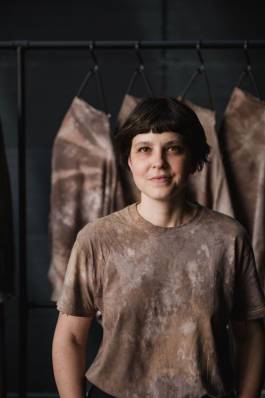
Christina Dörfler, portrait by Natascha Unkart
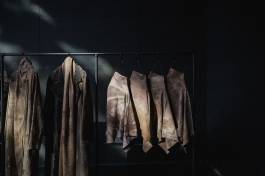
Christina Dörfler, “Excuse My Dust Series”, 2024, installation view (detail), MACRO - Museum of Contemporary Art, Rome, within “Critical Fashion”
Photo by Natascha Unkart
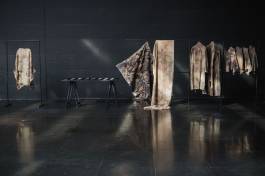
Christina Dörfler, “Excuse My Dust Series”, 2024, installation view, MACRO - Museum of Contemporary Art, Rome, within “Critical Fashion”
Photo by Natascha Unkart